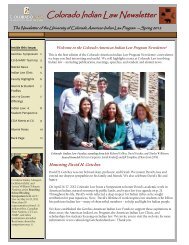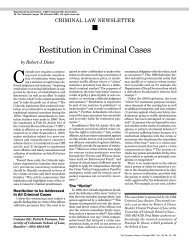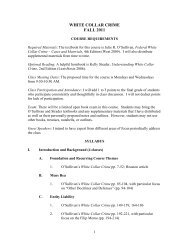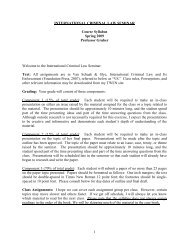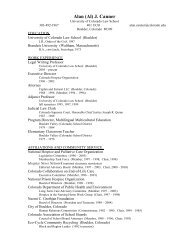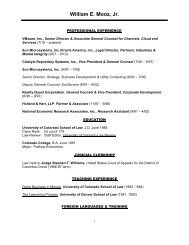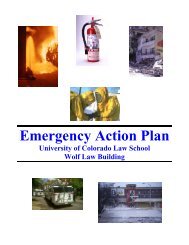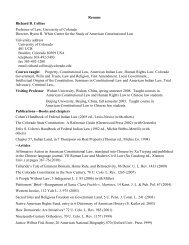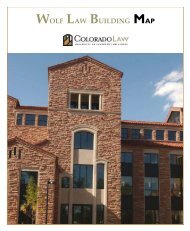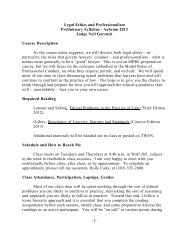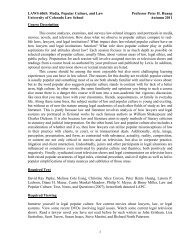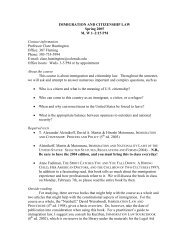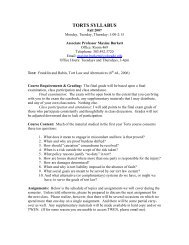CRIMINAL LAW SYLLABUS - Colorado Law
CRIMINAL LAW SYLLABUS - Colorado Law
CRIMINAL LAW SYLLABUS - Colorado Law
Create successful ePaper yourself
Turn your PDF publications into a flip-book with our unique Google optimized e-Paper software.
<strong>CRIMINAL</strong> <strong>LAW</strong><br />
Spring 2005<br />
Professor Carolyn Ramsey<br />
In this course, we will explore the criminal law from a variety of perspectives. We will study the<br />
reasons for punishing convicted criminals, as well as the elements of crimes and the defenses that<br />
the accused might raise. We will examine tensions between various state statutes, the common<br />
law, and the Model Penal Code. Although you will be responsible for learning criminal law<br />
doctrine, it is equally important for you to learn to make the best legal argument on each side of a<br />
case and to analyze the policy reasons for embracing or criticizing current laws.<br />
Criminal law does not constitute a uniform body of rules across jurisdictions. In this class, we<br />
will often talk about majority and minority trends in the nation, rather than trying to learn the<br />
doctrine of all 50 states plus the District of Columbia.<br />
Required reading assignments:<br />
Our casebook is KADISH & SCHULHOFER, <strong>CRIMINAL</strong> <strong>LAW</strong> AND ITS PROCESSES (7 th ed. 2001).<br />
Page numbers below refer to the casebook, unless otherwise indicated. The Model Penal Code<br />
(“MPC”) is in the casebook’s Appendix, starting on page 1031. Cases that do not appear in the<br />
casebook are accessible on Westlaw. The Westlaw cases are not edited, which will give you<br />
some practice at identifying the relevant issues in a full-text case (the kind you’ll encounter in<br />
the real world!).<br />
Each numbered sub-heading in the syllabus below corresponds to approximately one day’s<br />
reading. However, we may go faster or more slowly than this estimated pace. It’s more<br />
important for you to grasp the material that we cover than to race through concepts with the goal<br />
of finishing every item in the initial course syllabus.<br />
If I change an assignment, I will let you know by sending out an email, making a posting to<br />
TWEN, and/or announcing it in class (see “TWEN” below).<br />
Final examination = almost 100 percent of the final grade<br />
You will be required to take a three-hour in-class exam that will count about almost 100 percent<br />
of your final grade (with additions and deductions for class participation—see below). This<br />
exam will be open book, which means that you may consult your casebook and any outlines that<br />
you have prepared, borrowed, or purchased. The exam will be time-pressured. Hence, although<br />
you may bring outlines and other materials into the exam room, you may not have time to<br />
consult them.<br />
Class participation points: 1 to 3 points added to or deducted from final exam score<br />
Class attendance and class participation are very important to your comprehension of the course<br />
material, as well as to your grade. Broadly speaking, there are two types of participation – good<br />
and unsatisfactory. I will add 1 to 3 points to your final grade for “good participation;” I reserve<br />
1
the right to subtract 1 to 3 points from your final grade for “unsatisfactory participation.”<br />
“Good participation” means coming to class on a regular basis; doing the assigned reading<br />
carefully; being ready to answer questions if I call on you; and occasionally volunteering<br />
questions or comments. To be a good participant, you do not always need to have the “right”<br />
answer, but you do need to give in-class problem-solving your best shot and to demonstrate that<br />
you’ve read and thought about the assignment. It’s the quality, not the quantity of your<br />
participation that counts!<br />
“Unsatisfactory participation” means being unprepared when I call on you; routinely coming<br />
to class late; carrying on conversations or surfing the Web when others (including myself) are<br />
speaking; and/or missing more than 20 percent of our class meetings.<br />
Modified Socratic method: I will call on students randomly to present case facts and holdings<br />
and answer questions. If you’re unprepared, please place a note on the lectern prior to class. If I<br />
receive a note from you, I won’t call on you. You don’t need to explain why you’re unprepared. I<br />
also encourage you to volunteer, and I hope that many of you will do so from time to time.<br />
The use of a modified Socratic method in my class is not designed to intimidate or humiliate you,<br />
but rather to teach you to be good lawyers. If you’re shy about public speaking, you need to start<br />
overcoming that inhibition now. I want to help you become better oral communicators, and my<br />
modified Socratic method is designed to facilitate that goal.<br />
Getting in touch with me outside of class:<br />
Office hours: TBA. If you can’t come to my office hours, you can make an appointment to meet<br />
me at another time.<br />
Office number: 407<br />
Email: carolyn.ramsey@colorado.edu<br />
Phone: (303) 735-5028<br />
TWEN<br />
Please sign up for the class on TWEN. I often communicate with students via email, and I may<br />
make important postings to the class website.<br />
TENTATIVE SCHEDULE (subject to modification!)<br />
INTRODUCTION<br />
1. Participants and Steps in the Criminal Justice Process:<br />
1-12.<br />
THE JUSTIFICATION OF PUNISHMENT<br />
2
1. Theories of Punishment I: Retribution and Prevention<br />
95-125.<br />
2. Theories of Punishment II: Rehabilitation and Incapacitation<br />
125-135<br />
3. Sentencing and Punishment<br />
135-43 (skip note after Bergman); 143-48 (skip the notes after Jackson); 150-56.<br />
DEFINING <strong>CRIMINAL</strong> CONDUCT: THE BASIC INGREDIENTS<br />
1. Actus Reus<br />
173-181 (stop after note 5). Please consider how the cases in this assignment would be decided<br />
under MPC §§ 2.01(1) & 2.01(2) on 1041.<br />
2. Omissions<br />
182-187 (stop after note 3); 190-196 (stop after note 3); MPC § 2.01(3) on 1041.<br />
3. Mens Rea<br />
203-12 (stop after note 1); MPC § 2.02 on 1041-42 & MPC § 1.13(10) on 1040-41.<br />
4. “Beyond a Reasonable Doubt” and Burdens of Proof:<br />
35-50. In connection with Patterson, please review New York Penal <strong>Law</strong> § 125.20 & New York<br />
Penal <strong>Law</strong> § 125.25 at 393-94.<br />
5. Mistake of Fact<br />
225-35; MPC § 2.04(1) & (2) on 1043.<br />
6. Strict Liability<br />
235-49.<br />
7. Mistake of <strong>Law</strong><br />
255-63 (skip Cheek and accompanying notes); 268-274; refer back to MPC § 2.04(1) & (2) on<br />
1043 and also read MPC § 2.04(3).<br />
HOMICIDE<br />
1. Intended Killings I: Premeditated Murder<br />
395-405; MPC §§ 210.0, 210.1, 210.2 on 1076-77.<br />
3
2. Intended Killings II: Provocation & Extreme Emotional Disturbance<br />
405-20 (stop at end of Note 3); MPC § 210.3(b) on 1077. In connection with Cassasa, please<br />
review the relevant New York statutes at 393-94.<br />
3. Unintended Killings I: Criminally Negligent Homicide<br />
425-39; MPC § 210.4 on 1077.<br />
4. Unintended Killings II: Reckless Manslaughter<br />
MPC § 210.3(a) on 1077.<br />
People v. Hall, 999 P.2d 207 (Colo. 2000) (on Westlaw).<br />
5. Unintended Killings III: “Depraved Heart” Murder<br />
439-48.<br />
Refer back to MPC § 210.2(b).<br />
6. Felony Murder I: Basic Doctrine<br />
448-55 (stop after note 5).<br />
7. Felony Murder II: Inherent Dangerousness and Merger Limitations<br />
459-71.<br />
8. Felony Murder III: Killings Not in Furtherance of the Felony<br />
471-83.<br />
9. The Death Penalty I: Philosophical & Empirical Arguments<br />
483-93.<br />
10. The Death Penalty II: Constitutional Limitations<br />
493-506; MPC § 210.6 on 1077-79.<br />
RAPE<br />
1. Actus Reus I<br />
323-38; MPC § 213.0 & 213.1 on 1082.<br />
2. Actus Reus II<br />
338-46.<br />
3. Mens Rea<br />
351-54; 358-63.<br />
People v. Mayberry, 542 P.2d 1337 (Cal. 1975) (on Westlaw).<br />
CAUSATION AND ATTEMPT<br />
1. Causation I: Foreseeability Issues<br />
4
517-28 (stop after note on omissions); MPC § 2.03 at 1042-43.<br />
2. Causation II: Subsequent Human Actions<br />
530-43 (stop after note 4).<br />
3. Causation III: Subsequent Reckless Actions<br />
545-51.<br />
4. Attempt I: Mens Rea<br />
554-64.<br />
5. Attempt II: Actus Reus—Preparation vs. Attempt<br />
564-72; 575-78 (stop at end of Note on Statutory Reform; 581-84; MPC § 5.01 at 1060-61.<br />
CONSPIRACY<br />
1. Conspiracy I: The Consequences of a Conspiracy Charge<br />
671-84.<br />
2. Conspiracy II: Accessorial Liability<br />
684-94.<br />
3. Conspiracy III: Actus Reus<br />
694-704; MPC § 5.03.<br />
4. Conspiracy IV: Mens Rea<br />
704-710 (through Note 1)<br />
Commonwealth v. Camerano, 677 N.E.2d 678 (Mass. App. 1997) (on Westlaw).<br />
EXCULPATION: JUSTIFICATION & EXCUSE<br />
1. Self Defense I<br />
749-63.<br />
2. Self Defense II (The Battered Woman Defense)<br />
763-85 (stop after note 7).<br />
3. Insanity<br />
842-845 (do not read material on Duress); 875-90; 905-909.<br />
5



